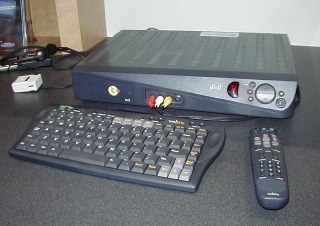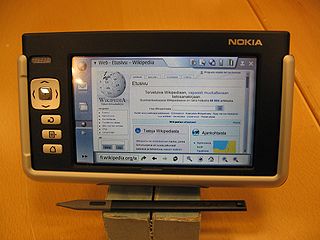Related Research Articles

The Memory Stick is a removable flash memory card format, originally launched by Sony in late 1998. In addition to the original Memory Stick, this family includes the Memory Stick PRO, a revision that allows greater maximum storage capacity and faster file transfer speeds; Memory Stick Duo, a small-form-factor version of the Memory Stick ; the even smaller Memory Stick Micro (M2), and the Memory Stick PRO-HG, a high speed variant of the PRO to be used in high-definition video and still cameras.

MSN TV was a web access product consisting of a thin client device that used a television for display, and the online service that supported it. The original WebTV device design and service were developed by WebTV Networks, Inc., a company started in 1995. The WebTV product was announced in July 1996 and later released on September 18, 1996. In April 1997, the company was purchased by Microsoft Corporation and in July 2001, was rebranded to MSN TV and absorbed into MSN.

A memory card is an electronic data storage device used for storing digital information, typically using flash memory. These are commonly used in digital portable electronic devices. They allow adding memory to such devices using a card in a socket instead of protruding USB flash drives.

Be Inc. was an American computer company that created and developed the BeOS and BeIA operating systems, and the BeBox personal computer. It was founded in 1990 by former Apple Computer executive Jean-Louis Gassée, who also served as the company's CEO, and was based in Menlo Park, California.

A USB flash drive is a data storage device that includes flash memory with an integrated USB interface. It is typically removable, rewritable and much smaller than an optical disc. Most weigh less than 30 g (1 oz). Since first appearing on the market in late 2000, as with virtually all other computer memory devices, storage capacities have risen while prices have dropped. As of March 2016, flash drives with anywhere from 8 to 256 gigabytes (GB) were frequently sold, while 512 GB and 1 terabyte (TB) units were less frequent. As of 2023, 2 TB flash drives were the largest currently in production. Some allow up to 100,000 write/erase cycles, depending on the exact type of memory chip used, and are thought to physically last between 10 and 100 years under normal circumstances.

The PlayStation Portable (PSP) is a handheld game console developed and marketed by Sony Interactive Entertainment. It was first released in Japan on December 12, 2004, in North America on March 24, 2005, and in PAL regions on September 1, 2005, and is the first handheld installment in the PlayStation line of consoles. As a seventh generation console, the PSP competed with the Nintendo DS.
Cisco PIX was a popular IP firewall and network address translation (NAT) appliance. It was one of the first products in this market segment.

A portable media player (PMP) or digital audio player (DAP) is a portable consumer electronics device capable of storing and playing digital media such as audio, images, and video files. The data is typically stored on a compact disc (CD), Digital Versatile Disc (DVD), Blu-ray Disc (BD), flash memory, microdrive, SD cards or hard drive; most earlier PMPs used physical media, but modern players mostly use flash memory. In contrast, analogue portable audio players play music from non-digital media that use analogue media, such as cassette tapes or vinyl records.
The Sony U series of subnotebook computers refers to two series of Sony products the PCG-U and the VGN-U. The later VGN-U were, at their release, the smallest independent computers running Windows XP and the most powerful high-end subnotebooks at the time. The VGN-U50 and VGN-U70P models are roughly the size of two DVD cases stacked on top of each other.

The Microdrive is a type of miniature, 1-inch hard disks produced by IBM and Hitachi. These rotational media storage devices were designed to fit in CompactFlash (CF) Type II slots.
TippingPoint Technologies was an American computer hardware and software company active between 1999 and 2015. Its focus was on network security products, particularly intrusion prevention systems for networks. In 2015, it was acquired by Trend Micro.

The Nokia 770 Internet Tablet is a wireless Internet appliance from Nokia, originally announced at the LinuxWorld Summit in New York City on 25 May 2005. It is designed for wireless Internet browsing and email functions and includes software such as Internet radio, an RSS news reader, ebook reader, image viewer and media players for selected types of media.

The 3Com Ergo Audrey is a discontinued internet appliance from 3Com. It was released to the public on October 17, 2000, for USD499 as the only device in the company's "Ergo" initiative to be sold. Once connected to an appropriate provider, users could access the internet, send and receive e-mail, play audio and video, and synchronize with up to two Palm OS-based devices.

The Sony Reader (ソニー・リーダー) was a line of e-book readers manufactured by Sony. The first model was the PRS-500 released in September 2006 and was related to the earlier Sony Librie, the first commercial E Ink e-reader in 2004 using an electronic paper display developed by E Ink Corporation. The last model was the PRS-T3, after which Sony announced it would no longer release a new consumer e-reader.

A tablet computer, commonly shortened to tablet, is a mobile device, typically with a mobile operating system and touchscreen display processing circuitry, and a rechargeable battery in a single, thin and flat package. Tablets, being computers, have similar capabilities, but lack some input/output (I/O) abilities that others have. Modern tablets largely resemble modern smartphones, the only differences being that tablets are relatively larger than smartphones, with screens 7 inches (18 cm) or larger, measured diagonally, and may not support access to a cellular network. Unlike laptops, tablets usually run mobile operating systems, alongside smartphones.

My Life Online (Mylo) was a device created and marketed by Sony for portable instant messaging and other Internet-based communications, browsing Internet web sites using the Opera web browser and playback and sharing of media files. The pocket-sized, tablet-shaped handheld device, which debuted in 2006, had a screen which slid up to reveal a QWERTY keyboard. The brand name 'Mylo' means My Life Online. Using Wi-Fi instead of cellular networks, the Mylo was targeted to the 18–24 age group.

The Sony Ericsson W200i Walkman is a cellphone measuring 101 × 44 × 18mm and weighs 85g (3 oz). It features a VGA camera, an FM radio, and Sony's Walkman software, although it lacks Bluetooth.
The MSN Companion was a small-scale personal computer terminal that was designed for easy access to MSN services on the Internet, such as Hotmail, while still being cheap and easy to use. They were intended for use by people with little knowledge of computers or technology, and many included several features aimed at the elderly or disabled, such as easier-to-read monitors. The device was designed by Microsoft.

The Intel-based MacBook Air is a discontinued line of notebook computers developed and manufactured by Apple Inc. from 2008 to 2020. The Air was originally positioned above the previous MacBook line as a premium ultraportable. Since then, the original MacBook's discontinuation in 2011, and lowered prices on subsequent iterations, made the Air Apple's entry-level notebook.
References
- ↑ "CNN.com - Sony launches Net access device - June 18, 2001". edition.cnn.com. Retrieved 2023-11-24.
- ↑ Twitter; Email; Facebook (August 31, 2001). "Sony to Abandon Its eVilla Net Device". Los Angeles Times. Retrieved 2023-11-24.
{{cite web}}:|last=has generic name (help) - ↑ "Sony axes eVilla Web-surfing appliance - CNET News". web.archive.org. 2001-08-31. Retrieved 2023-11-24.
- 1 2 "Sony trots out Web-browsing eVilla with Be OS - CNET News". web.archive.org. January 8, 2001. Retrieved 2023-11-24.
- ↑ Jean, Laura (2001). "iApplianceWeb-OEG". web.archive.org. Retrieved 2023-11-24.